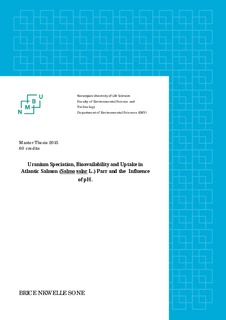| dc.description.abstract | Many chemicals move readily in the environment and can be transported with surface water runoff to a nearby stream or lake. So, risk assessments need to be mindful of environmental movement of chemicals and the fact that exposure to biota could occur through a variety of pathways. Regularly, exposures can lead to uptake of a chemical by more than one route. The present study was based on controlled acute experiments (96h) with uranium (U) and Atlantic salmon (Salmo salar L.) parr systematically exposed to synthetic waters with the same U concentration at different pH water groups comprising of pH 5.4, pH 5.7, pH 6.5 reference water, pH 6.8, pH 7.2 and pH 7.7 respectively, at 1.0 mg U/L nominal concentration. The aim was to have a general idea of U speciation and accumulation across a wide range of pH, as contribution in the development of an acute U-Biotic Ligand Model (BLM). Speciation information of U based on charge and size fractionation at pH 5.5 with varying U concentrations (0.46, 0.96 and 1.92 mg U/L), showed that 95 % of the total U was found in the dissolved (< 0.45 µm) fraction with insignificant concentrations of particles (< 10 %). Of the dissolved fraction, 95 % was present as LMM species (cutoff < 10 kDa), suggesting the possibility of highly mobile and potentially bioavailable U species. Based on ultrafiltration and fractions retained on the anion exchange column, 30-35 % was found in the colloidal fraction. In fish exposed at 1 mg U/L, the mean U concentrations ranged from 3.2 mg/kg dw to 58.6 mg/kg dw in gills, 0.13 mg/kg dw to 1.17 mg/kg dw in liver, and 0.014 mg/kg dw to 0.80 mg/kg dw in kidney. The observed trend in mean U concentration in tissues was gill > liver > kidney. The highest accumulation of U in gills, liver and kidney was observed at pH 5.4 and pH 5.7 waters. Statistical test comparing mean U concentration accumulated in tissues and all pH water groups, showed significant (Turkey's One-way ANOVA Post hoc tests: p < 0.01, r2 = 89.7 %) differences in mean gill U concentration between pH 5.4 and pH 5.7, and the other pH groups. There was also evidence of significantly different U concentration in liver (p < 0.01, r2 = 65.9 %) and kidney (p < 0.01, r2 = 46.9 %). The good relationship between concentrations of U in tissues and pH water groups indicated that pH is a significant factor influencing U speciation in freshwater, bioavailability, uptake and accumulation in fish. So, speciation information on U and its fate in the environment depending on pH being an important factor can be very useful in U-BLM modelling and thereby in risk assessment of natural waters. | nb_NO |

